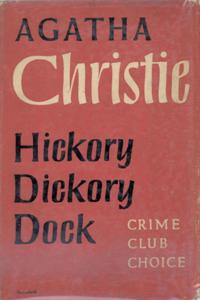Hickory Dickory Dock (novel)

Dust-jacket illustration of the first UK edition
|
|
| Author | Agatha Christie |
|---|---|
| Cover artist | William Randall |
| Country | United Kingdom |
| Language | English |
| Genre | Crime novel |
| Publisher | Collins Crime Club |
|
Publication date
|
31 October 1955 |
| Media type | Print (hardback & paperback) |
| Pages | 192 pp (first edition, hardback) |
| Preceded by | Destination Unknown |
| Followed by | Dead Man's Folly |
Hickory Dickory Dock is a work of detective fiction by Agatha Christie and first published in the UK by the Collins Crime Club on 31 October 1955 and in the US by Dodd, Mead and Company in November of the same year under the title of Hickory Dickory Death. The UK edition retailed at ten shillings and sixpence (10/6) and the US edition at $3.00. It features her Belgian detective Hercule Poirot. The novel is notable for featuring Poirot's efficient secretary, Miss Felicity Lemon, who had previously only appeared in the Poirot short stories.
An outbreak of apparent kleptomania at a student hostel arouses Hercule Poirot's interest when he sees the bizarre list of stolen and vandalised items. These include a stethoscope, some lightbulbs, some old flannel trousers, a box of chocolates, a slashed rucksack, some boracic powder and a diamond ring later found in a bowl of a soup – he congratulates the warden, Mrs Hubbard, on a 'unique and beautiful problem'.
Poirot's solution of the petty thefts is unsubtle but effective: once he has threatened to call in the police, Celia Austin quickly confesses to the pettier incidents. She denies, however, the following: stealing Nigel Chapman's green ink and using it to deface Elizabeth Johnston's work; taking the stethoscope, the light bulbs and boracic powder; and cutting up and concealing a rucksack. She committed the lesser thefts to attract the attention of Colin McNabb, a psychology student who then becomes engaged to her. She makes restitution for the crimes and reconciles with her victims. The more important incidents remain unsolved. Celia is discovered dead the following morning from an overdose of morphine. It does not take investigators long to see that her death is murder.
Inspector Sharpe solves the mystery of the stolen stethoscope during his interviews with the inhabitants of the hostel. Nigel Chapman admits to having stolen the stethoscope to pose as a doctor and steal some morphine tartrate from the hospital dispensary as part of a bet to acquire three deadly poisons (the other two being digitalin and hyoscine). He claims the poisons were carefully disposed of, but cannot be sure that the morphine was not stolen from him while it was in his possession. Poirot turns his attention to the reappearance of the diamond ring, and confronts Valerie Hobhouse, in whose soup the ring was found. It seems that the diamond had been replaced with a zircon and that only Valerie could place it in the dish of soup; Poirot accuses her of having stolen the diamond. She admits to having done so, saying that she needed the money to pay off gambling debts. She also admits to having planted in Celia Austin's mind the idea of the thefts.
...
Wikipedia
